Helping Our Small Businesses, Saving Our Retail Corridors, Improving Our Neighborhoods
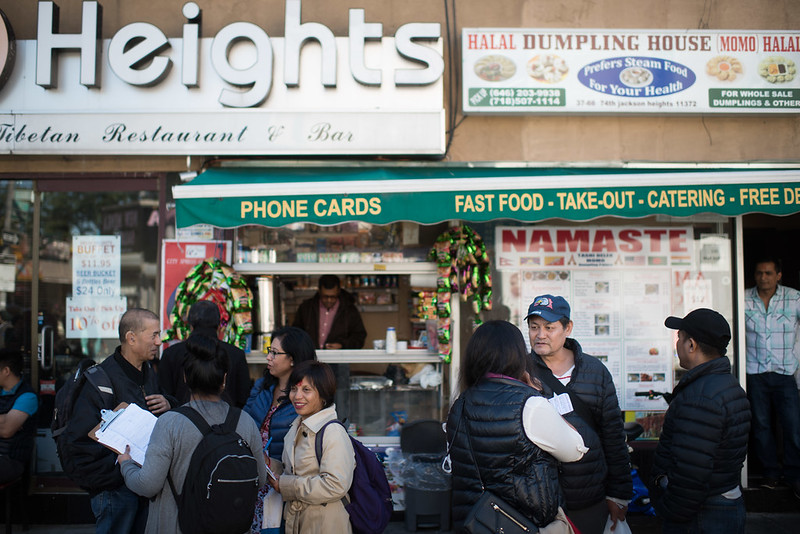
(photo: Michael Appleton/Mayor's Office)
Ask any New Yorker and they will tell you how neighborhood streets that once bustled with small, mom-and-pop businesses now have a Duane Reade on one corner and a large bank on the other, with a row of empty stores in between. When I was growing up in Washington Heights, like a lot of New Yorkers, I could walk down the street to the local corner store where they knew my name and could even guess what I wanted before I started talking. That’s what made growing up in the city so special – the local institutions embedded in the fabric of our neighborhoods. But nowadays, that reality is disappearing.
This is a moment of tremendous challenge for the thousands of local small businesses that have been a source of vibrancy, character, and diversity for our neighborhoods for generations. Tragically, these vital establishments are closing at an alarming rate from one end of the city to the other. Every New Yorker sees it — and feels it, too.
Last week, my office released the most comprehensive analysis to date in a first-of-its-kind report, reviewing data from the Department of Finance over a decade that puts numbers behind the phenomenon of retail vacancies playing out across the city.
What we found was that the amount of vacant storefront space across the city has doubled since 2007 — from around 6 million square feet to more than 11 million square feet. The city’s vacancy rate citywide rose by 45 percent from 2007 to 2017, to nearly 6 percent. The report offers a startling picture of new economic trends in communities across the five boroughs.
While Manhattan neighborhoods account for nearly half of the 20 neighborhoods with the most empty square footage -- including Chelsea, Canal Street, and even along 5th Avenue -- the neighborhoods with the highest rates of vacancy are in the other boroughs, in neighborhoods from Little Neck and Jackson Heights in Queens to Throggs Neck and Mott Haven in the Bronx and New Dorp and Rossville on Staten Island.
The reasons for this are complex but nonetheless crucial for us to consider and comprehend if we’re going to give mom-and-pop businesses a fighting chance – not just to stay afloat, but to thrive.
Yes, there are landlords who are pushing for the highest rents they can set and are willing to let storefronts sit empty for months to do so. But it’s not just that – it’s also the changing nature of how people shop today. Call it the “Amazon Effect,” where we increasingly buy everything from mattresses to groceries online. As a result, we’re seeing an exodus of traditional merchandise stores, replaced with new businesses that are service-oriented.
The result is a wave of closures of flower shops, independent pharmacies, bookstores, and more. Independent bookstores and pharmacies are being replaced by chain coffee shops, cycling studios, and doggie daycare. Between 2007 and 2017, the number of service businesses rose by nearly 50 percent, and bars and restaurants soared by 65 percent – while traditional retail storefronts grew by just 19 percent.
Meanwhile, rents are rising on ground-floor retail — by 22 percent citywide from 2007 to 2017, and by much more in neighborhoods from Greenwich Village to Douglaston, Annandale to Central Harlem — hurting our smaller, independent stores the most. They are being hit twice, by changing shopping habits and rising rents, and it’s making it almost impossible to compete with online retailers.
If we’re going to offer relief, we should be taking a hard look at the regulatory hurdles that stall turnover of retail space. There’s a lot that needs to happen for a bookstore to become a coffee shop: licenses have to be approved by a community board and agencies need to approve alterations and conduct inspections for health and safety. The process is confusing and convoluted — and it’s making vacancies more common, and more prolonged, while hurting the chances that new businesses are run by New Yorkers invested in their local communities instead of big corporations.
We must streamline the process. We can create a one-stop shop for our small businesses, and break down the silos in city government that are hurting, not helping. The bureaucracy has to act faster and in a much more coordinated fashion. Our city agencies must get on a track to streamline those conversions and make it easier to open up shop.
Let’s also help new retail businesses get a foothold by offering a tax break to independent local businesses — not national chains — in high-vacancy retail corridors. And let’s use this data to plan our city with retail space in mind. Too often developers build out retail space that ends up sitting vacant. We need to plan smarter, more comprehensively, and embrace an approach to planning for new residential and commercial buildings that allows neighborhoods to capture diverse retail opportunities.
If we don’t adapt, our local businesses that define our neighborhoods, bring life to our city, and provide goods and services to residents they’ve built relationships with, will disappear.
It’s time we rethink our approach to support our local neighborhood anchors, the mom-and-pop stores that line our streetscapes and serve as some of our most vivid markers in communities across the city. Understanding the changing reality is the place to start. We have the power to shape our commercial corridors and therefore our neighborhoods — let’s take the right steps to move them forward.
***
Scott Stringer is the New York City Comptroller. On Twitter @NYCComptroller.
***
Have an op-ed idea or submission for Gotham Gazette? Email This email address is being protected from spambots. You need JavaScript enabled to view it.
Ranked-Choice Voting is the Next Step in New York Voter Empowerment
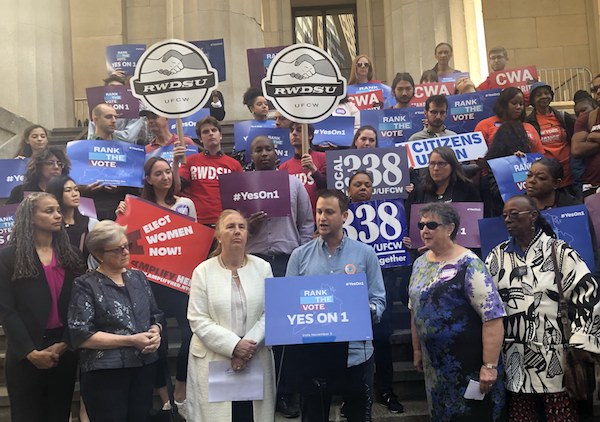
At Empire State Indivisible, lowering the barriers to engage in our representative democracy has always been the guiding light for our organizing efforts. It is why, in coalition with grassroots organizers across the state, we fought so hard to engage voters to defeat the former members of the Independent Democratic Conference and then to elect a true Democratic state Senate majority in Albany. And it is why we continue to work so closely with allies to deliver critical voting and campaign finance reforms at the state level. Simply put: we need to expand the electorate and strengthen our representation in the face of increasingly hostile and emboldened attacks on our democracy.
This fall, New York City has the opportunity to go one step further. Voters across the five boroughs have the opportunity to once again lead the state forward by embracing a ranked-choice voting system through a “yes” vote on ballot proposal 1.
Ranked-choice voting will uplift and strengthen the voices of everyday New Yorkers while encouraging a diverse set of candidates who seek to represent their full constituencies. And it’s critical we recognize the additive power of those two outcomes.
The status quo of our electoral politics in this country has left a massive void between the organizing required to win an election and the organizing required to properly represent your constituents. And this has led to an increasingly disconnected electorate and plenty of examples of ineffective governance. But we have started to see a shift.
The last two years have shown the promise of progress that is enabled by candidates who get elected based on grassroots organizing and an engaged constituency. Much attention has been focused on the election results themselves. But it was also the commitment to organizing post-election and the prioritization of constituent advocacy from those electeds that led to a string of massive results this past legislative session in Albany. In other words, an engaged constituency is the single most powerful enabler of progressive democracy.
Ranked-choice voting rewards those who recognize the power of this virtuous engagement cycle.
Ranked-choice voting also has the power to excite those who may have previously sat on the sidelines. Elections are about choice. But far too often, elections become about divisiveness. We have heard time and time again during our canvassing of the city and state that our elections have become too divisive. The negativity is driving away otherwise active community members and we can’t afford to keep up that trajectory.
By enabling New Yorkers to choose multiple candidates by ranking their preferences in a crowded field, we can envision a more productive and more positive approach to our elections; candidates will seek to appeal to more voters and run more positive campaigns about vision and progress. One in which candidates recognize the power of their shared views and embrace the power of organizing around ideas instead of power.
We believe New York City is best when it leads. And we believe ranked-choice voting leads to the right incentives for a healthy and engaged democracy. One of the victories achieved through the new state Senate majority is the early voting system that will be launched starting this October, providing voters the chance to cast their ballots more conveniently.
Ranked-choice voting, placed on the ballot by a New York City charter revision commission, can be another step in voter empowerment.Vote “yes” on ballot proposal one this fall and help approve ranked-choice voting for New York City.
***
Ricky Silver is co-lead organizer of Empire State Indivisible. On Twitter at @es_indivisible.
***
Have an op-ed idea or submission for Gotham Gazette? Email This email address is being protected from spambots. You need JavaScript enabled to view it.
Manhattan Democrats Just Elected New County Party Reps, But Their Voices May Not Be Heard Until 2021
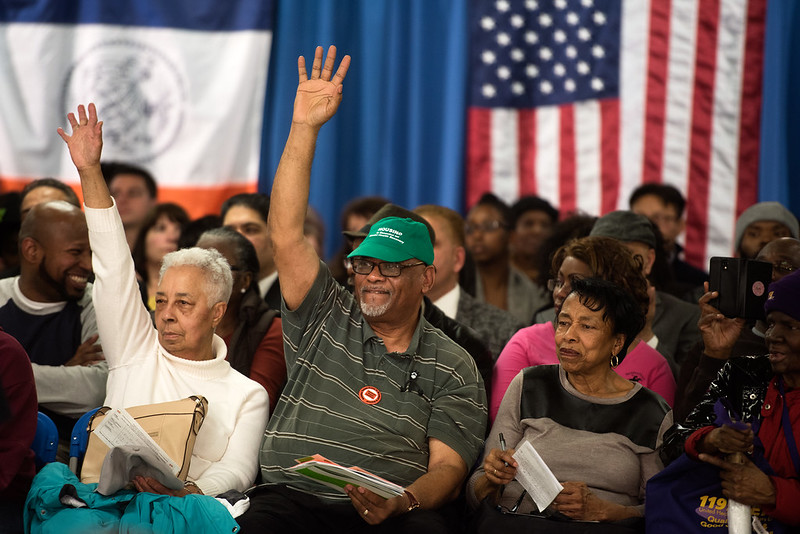
(photo: Demetrius Freeman/Mayoral Photography Office)
This past Thursday, the Manhattan Democratic Party announced its bi-annual “Organization Meeting” for this coming Thursday, October 3. This gathering of the party’s over 2,000 County Committee members is a critical moment when those newly elected representatives of Democratic voters set the course for the Democratic Party going into 2020.
Or so everyone thought.
Disregarding the exceedingly short notice, which is sent by mail and won’t reach most County Committee members until mere days before the meeting, nobody even knows who will be allowed to vote.
The 2018 elections were a watershed moment in United States politics, shifting the House of Representatives to Democratic control, but also many state legislatures; New York was a prime example. Here, activists worked tirelessly to unseat the former members of the Independent Democratic Conference (IDC) -- a group of State Senators who worked with Republicans to hold up a backlog of nearly 40 years worth of progressive legislation --and to flip several GOP seats to Democrats.
In that backlog were staples of the progressive agenda such as codifying Roe v. Wade and securing a better rent-stabilization program for New York City. Included in the changes that swept through Albany was a bill to merge the multiple primary election dates. The goal was to increase voter turnout by putting all our primary elections on the same day (except the presidential primary, which is in April). Because federal primaries couldn’t be made later due to federal law, state primaries were moved to June.
In the minutiae of election law is a simple provision - political parties must convene their county committees, which are elected in the primary, within 30 days of said primary. With the change to a June primary, however, that would put the organizational meetings in July. Manhattan and Staten Island, whose voters elected county committee membership this year, worried that nobody would be around. In response, the state legislature quietly changed the law to set the date of the organizational meetings between September 16 and October 6. It furthermore prescribed that the previous county committee holds power “until” the meeting while the newly elected committee assumes power “after” the meeting.
While Staten Island Democratic County Committee members met and their 2019 members elected new county party leadership without controversy, Manhattan faces a different situation. Contested elections for leadership, new ideas for organizing, and a controversial proposal to ban registered lobbyists from top party positions have led to arguments as to which cohort of the Manhattan Democratic County Committee will be allowed to vote - delegates elected by voters in 2017, or those elected this year.
With the Manhattan county committee organizational meeting and its elections just days away, the debate continues.
Since 2017, the number of people who did the work of gathering signatures to run for county committee has grown by around 600. Many got involved because of Donald Trump’s election in 2016 and wanted to do more for 2020. It’s unlikely they’ll appreciate being cut out of Democratic Party decision making, but it’s not up to them. Though the bill authors in the state legislature and officials at the State Board of Elections have said the intent is for members elected in 2019 to vote in 2019, those local party representatives may have to wait until 2021 to impact how the Democratic Party does business.
***
Ben Yee is a civic educator and organizer in New York City. He currently serves as Secretary of the Manhattan Demcoratic Party and Democratic State Committeeman for New York’s 66th Assembly District. Chair. He is currently a candidate for Manhattan County Committee leadership. On Twitter at @yben.
***
Have an op-ed idea or submission for Gotham Gazette? Email This email address is being protected from spambots. You need JavaScript enabled to view it.
Reining in the Maleficent Middlemen: Governor Cuomo Should Sign America’s Toughest Prescription Drug Legislation

(photo: Kevin P. Coughlin/Office of the Governor)
Like the rest of America, New York State is ensnared in the stranglehold of our byzantine healthcare system, which today is best known for skyrocketing pharmaceutical drug prices and a rapid decline in quality of care. One of the most vicious, insidious, and disingenuous tentacles of that system choking the life out of us is the group of corporations known as Pharmacy Benefit Managers (PBMs).
While just three Fortune 25 companies – CVS, Express Scripts, and OptumRx – control nearly 80% of the pharmacy benefits market, most Americans are unaware of the outsized role PBMs play in their healthcare. And PBMs want to keep it that way.
Hired by insurance companies as their prescription drug middlemen, PBMs claim they play an important role in making prescription drugs accessible and affordable for consumers – including in New York’s Medicaid program – by negotiating prices with manufacturers.
In reality, however, PBMs control which medications are covered by insurance, what patients pay out-of-pocket and the amount pharmacies get reimbursed for dispensing them. PBMs are unregulated thieves who are not required to — and therefore don’t — disclose how much money they take in, how much they pay out, or the savings they achieve through this process.
When challenged to provide more transparency about their business practices, PBMs flat-out refuse. Why? Because a lack of oversight is their key source of power. And it’s the consumers, and the pharmacies that dispense medications, who pay the price.
According to a study by the Pharmacists Society of the State of New York (PSSNY), PBMs last year pocketed 24% of New York State Medicaid managed care spending. That adds up to more than $300 million in taxpayer money in the hands of giant corporate middlemen that do not actually provide any healthcare service.
How did they do that? Through a nasty practice called “spread pricing,” in which a PBM bills an insurer for prescription drug claims at one rate and then reimburses the pharmacies that filled those prescriptions at a substantially lower rate. The difference, which PBMs pocket, is called the “spread.”
Thanks to Governor Cuomo and the state Legislature, New York in April became among the first states in the country to eliminate spread pricing in Medicaid managed care. This was a tremendous step in the right direction. But PBMs continue to hurt patients, taxpayers, and independent pharmacies.
The good news for New Yorkers — potentially excellent, game-changing news — is that the New York Senate and Assembly recently passed legislation that at last would impose common-sense requirements on PBMs aimed at fostering greater transparency.
These new regulations, which await Governor Cuomo’s signature to become law, have been described as the toughest PBM legislation in America, offering significant, critical protections to patients, taxpayers, and neighborhood pharmacy owners — and a roadmap for the rest of America to follow.
In short, the regulations would further curtail spread pricing beyond Medicaid managed care, require PBMs to disclose previously confidential information, and give pharmacies the mechanisms they need to seek recourse for abusive PBM practices.
We know that deep-pocketed PBMs — which only care about their profits — have an array of lobbyists trying to water down, if not outright kill these regulations. We cannot afford to be bullied and manipulated by PBMs any longer. It is time to end this abusive system that preys on citizens.
Other states are taking action, too. Ohio recently dumped PBMs for billing Medicaid $244 million more than they paid pharmacies, awarded $100 million to independent pharmacies for their losses, and introduced a new state program, transparent in nature and defined as a pass-through PBM. We applaud that action, too. But New York has an opportunity to take a major step forward here.
That is why we stand behind Governor Cuomo, who time and again has proven that he fights for New Yorkers and is one of America’s most progressive leaders.
PBMs are destroying our healthcare system. We need to reign in their ability to control the medications physicians prescribe. Let me ask: Who do you think should be dictating healthcare strategies? Soulless PBMs, who are not in the healthcare business, but the money-making business, or our doctors and pharmacists, trained and licensed professionals dedicated to keeping us healthy?
PBMs are not going away. But we are on the verge of a historic moment, not just for New Yorkers, but for all Americans. And when Governor Cuomo signs these regulations into law, we will be there to celebrate.
***
Yuriy Davydov, Pharm D., is the Founder & CEO of Zero Copay Program (ZCP), a pass-through PBM. On Twitter @ZCP_Inc.
***
Have an op-ed idea or submission for Gotham Gazette? Email This email address is being protected from spambots. You need JavaScript enabled to view it.
Racing to the Scene of the Wrong Emergency

(photo: Demetrius Freeman/Mayoral Photography Office)
The New York Times recently published a two-column editorial advocating that the city’s emergency medical technicians (EMTs) and paramedics be paid close to or as much as its firefighters. Far easier for the Times to virtue-posture by supporting more pay for hard-working, largely of color EMTs than to address how the increased expense should be funded or how to remedy the astonishing imbalance in resources devoted to firefighting versus to emergency medical response.
The editorial speaks movingly about the importance and stresses of emergency medical service work, but simply notes blithely two remarkable problems. First, the salary increases would mean dramatically raising base pay after five years on the job, from about $50,000 for EMTs and $65,000 for paramedics to the $85,000 base pay of firefighters, at a cost of half-a-billion dollars a year. Second, the reason the job of EMTs and paramedics has become so important and challenging is that the vast majority of emergency calls in New York City are now not about fires, but medical needs.
More than 80% of emergency incident calls to 911 in New York City – almost 1.5 million out of a total of 1.9 million calls a year – are medical, not fire-related. Yet there are only 4,300 EMTs and paramedics employed by the FDNY. In contrast, there are 11,000 firefighters to respond to 40,000 fires a year, only about 2,000 of which are deemed serious structural fires. A relatively small percentage of medical emergency calls are handled by private ambulances, but the contrast between medical and fire calls handled by FDNY is still dramatic.
Medical emergencies have far outnumbered fires since the Emergency Medical Service merged into the FDNY in 1996. New and renovated buildings are now generally well-fireproofed due to strong building codes and improved technology has cut down on the number of false alarms. Meanwhile the aging and growth of the city’s population, the drug addiction crisis, and other factors have led to a dramatic rise in the need for emergency medical response.
The number of medical incidents to which the FDNY responds is 25 times that of fire-related incidents and more than 38 times that of structural fires, yet more than 70% of the FDNY budget and two-thirds of its personnel are devoted to staffing fire units.
Firefighters assigned to engine (as opposed to ladder) companies must receive training as Certified First Responders with Defibrillation (CFR-D) and these companies are dispatched to respond to some medical emergencies. They can often arrive more quickly than an ambulance staffed by EMTs and/or paramedics, but CFR-D firefighters are not able to transport patients to a hospital, or administer intravenous or medication or other types of medical intervention, so in most cases (70% require transport), an ambulance must also respond and take over. The deployment of engine companies, each staffed by four or five firefighters and an officer, thus gives the firefighters more “runs” but they are mostly redundant and extremely expensive.
There is a great deal of emphasis in public discussion of emergency medical services on response time, i.e. how long it takes for a fire truck or ambulance to arrive on the scene of a call. While the average response time for both ambulances and fire engines has risen a few seconds over recent years, the vast majority of calls are for situations that are not life-threatening and for which response time is not a critical issue.
Deployment of more staff and ambulances that can respond more promptly to the most serious incidents would be more efficient and effective. The increased costs could be offset by reducing the number of fire engines and ladders, which are no longer necessary given the reduced level of firefighting—but an effort to right size firefighting resources is regarded as politically untenable because no one ever wants to lose a firehouse nearby, regardless of how busy it is.
Another approach, adopted successfully in Houston, would be to require firefighters to receive EMS and/or paramedical training so that fire engines can provide the full range of services needed for medical calls, including transport.
But again, the obstacles are primarily political – firefighters would resist the additional training requirements and the unions representing EMTs and paramedics would howl at further erosion in their numbers (many already leave to take advantage of the priority they are given to become firefighters).
Although FDNY recognizes the need to reconfigure the department, it has not made significant efforts to do so. In 2016 it instituted a pilot program in the Bronx of using “fly cars,” SUVs staffed by EMT supervisors and paramedics, to respond to life-threatening incidents along with an ambulance and instead of fire engines. It reduced response times by more than one minute. It has been announced that this program will be expanded in October but no details have been provided.
Instead of talking about the difficult but necessary steps to provide more and better ambulance service to New York City residents, the Times and elected officials – many of whom just rallied with EMTs on the steps of City Hall – are choosing the easy message that makes no one unhappy but solves very little: pay more to the stressed and stretched EMTs and paramedics but ignore the serious underlying structural problems that will continue to plague the city’s emergency response system in the absence of an honest discussion and real leadership.
***
Carol Kellermann was president of Citizens Budget Commission from 2008 through 2018.
***
Have an op-ed idea or submission for Gotham Gazette? Email This email address is being protected from spambots. You need JavaScript enabled to view it.
Recognizing and Responding to Addiction: What to Know for National Recovery Month and Beyond
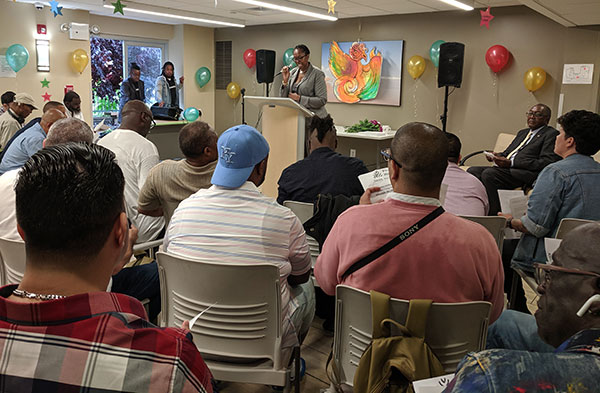
Ann-Marie K. Foster, the author, addresses program participants (photo: Phoenix Houses)
It’s often said, but worth repeating during National Recovery Month: addiction does not discriminate. Drugs can hook anyone, anytime, anywhere—and it’s more of a problem now than it’s ever been. In New York, for instance, there were more opioid-related overdose deaths in 2017 than there were in the first six years of the 2000s combined.
Today, the types of drugs available are also terrifyingly effective at creating addicts. Fentanyl and other synthetic drugs are perhaps the worst among them. They are 50-times stronger than heroin and 100-times stronger than morphine. They are also cheap and fairly easy to find in New York. And, they flooded in so fast that we are only now fully realizing the seriousness of this public health issue.
There are some obvious actions government can take to turn this crisis around. Continuing to fund state treatment programs and ensuring life-saving medicines are available statewide should be essential parts of any plan. Reducing access to dangerous illegal drugs and engaging in serious education campaigns to prevent use in the first place is also necessary.
But even all of that will never fully free us from the eternal epidemic of addiction. Addiction is wickedly persistent. It has followed us through the centuries and always finds a way to come back in one form or another. But recovery is possible.
National Recovery Month is an effort to increase awareness and understanding of substance use disorders. Everyone should be armed with the knowledge necessary to identify the warning signs of addiction in a loved one because anyone could be an addict. And it could save their life.
The main signs of addiction are: change in baseline behavior from normal; spending more time alone; irritability; mood swings; change in sleeping habits; change in diet and weight gain or loss; eyes dilated or pin-pointed.
As the largest provider of addiction treatment services in New York, we also see other common trends amongst our patients. The majority of the patients we treat have experienced trauma or have other co-existing health or mental conditions. Many are also dealing with deep guilt, regret, and self-loathing about their behavior and the consequences of their actions, which can manifest itself in various, often destructive, ways.
We believe in treating the whole person to promote the message that recovery in all forms is possible. So we provide medical and dental care, wellness programs, community support, and even recreational activities as part of our continuum of care in addition to evidence-based treatment.
But, ultimately, overcoming addiction is often about the people around the patient. That is why it is so essential that New Yorkers of all backgrounds have the knowledge to identify addiction, the strength to talk to their loved one about it, and the compassion to support them through recovery.
In this time of crisis, don’t be afraid to talk to a loved one about their possible addiction. And don’t be afraid to ask for help. Addiction is a scary place to be, but there are always paths out. With care and the right tools, addiction doesn’t have to win. First though we have to have the will to fight it.
***
Ann-Marie K. Foster is the CEO & President of Phoenix Houses of New York & Long Island. On Twitter @PhoenixHousesNY.
***
Have an op-ed idea or submission for Gotham Gazette? Email This email address is being protected from spambots. You need JavaScript enabled to view it.
Soil Scientists’ Advice to Urban Gardeners: Test for Lead
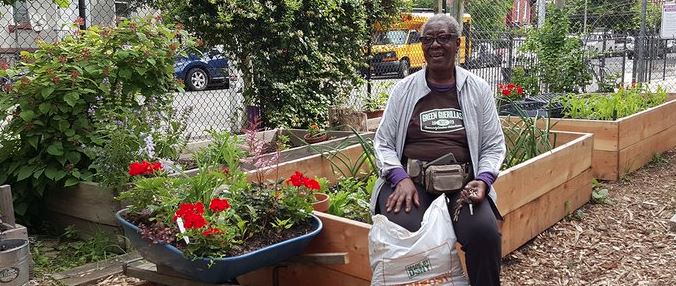
(photo: @NYCzerowaste)
In the past few years, the issue of soil contamination has gained the attention of environmental groups in New York City. New Yorkers have ample reason to be concerned about their soil. While the city is cleaner than it used to be, decades of pollution left our local soil thick with toxic levels of heavy metals. For years, the presence and persistence of these toxicants were unknown, posing risks to all urban residents.
Fortunately, public support for environmental protection has rehabilitated much of our city soil. But, there is still more that New Yorkers can do, and Climate Change Week NYC is a good time for us to consider how activities like urban gardening and farming can be done in a way that is both healthy for humans and helps to improve the environment and potentially mitigate climate change.
Abating contaminated soil with organic matter helps reduce greenhouse gas emissions because compost sequesters carbon, diverting it from the atmosphere.
Soil testing labs, public initiatives, and grassroots efforts have done wonders to educate New Yorkers on soil quality and remediation techniques. Urban gardeners began transforming vacant lots in New York City in the 1970s, and such activities have grown in popularity in the past decade. As of 2019, New York City has the largest urban agricultural system in the country, with over 1,900 community gardens and thousands of home gardens growing food and providing other benefits for city residents.
But New Yorkers should be reminded that our soil is still far from pure, and it may likely contain contaminants, like lead and arsenic that we should detect and remediate to avoid exposing our families to harmful consequences. Like any hobby, urban gardening requires preparation, and we must remember to test our soil, change it when possible, and choose our crops carefully so we can reap the best from what we sow.
Testing your soil is your first line of defense against soil-based contaminants. Soil testing labs, like those at Brooklyn College and NYC Urban Soils Institute offer a variety of affordable tests to assess soil characteristics. Generally, you should take several samples from various locations in your garden, combine them, thoroughly mix, and take one cup of representative soil sample to be submitted to the lab. You can request any number of tests on texture, organic content, pH, nutrients, and so forth, although you’ll usually want to start with lead. These labs usually return results between 2-3 weeks.
Testing for the total concentration of lead will provide a broad sense of the soil’s need for remediation. Bear in mind that the total concentration doesn’t always indicate the soil is poor for gardening. Rather, it’s the bioavailability of lead -- how readily it’s absorbed by our gastric systems -- that determines risk. Nevertheless, understanding the total concentration of lead can inform your soil remediation or amendment strategy.
A Columbia University research team has developed a field testing kit that screens soil for hazardous lead, although it’s not yet on the market.
Once you understand your soil characteristics, you can make choices about removing your soil, adding amendments, or bringing in a new soil cover. Compost is the most common and useful amendment, as it contributes organic material for microorganisms to digest, balances the soil pH, and improves soil structure.
There are many organizations that give away free compost (including the Department of Sanitation, and community composters with the NYC Compost Project). You can also purchase compost, or make your own from common kitchen waste -- with the awareness that uncovered scraps can attract scavengers -- and alternate these ‘wet’ layers with dry forms of compost, such as wheat, sawdust pellets, or leaves.
For community-based organizations with reservations about the quality of local soil, there are other options. A helpful approach is to cover the contaminated soil with a layer of clean soil followed by layers of compost. Separating the old soil from the new with a layer of landscape fabric can prevent mixing and later contamination. The New York City Mayor’s Office of Environmental Remediation developed the Clean Soil Bank that takes clean native subsoil from construction sites and makes it available to local organizations or businesses that request it. The soil is available for free for sites that can receive a load of at least 20 cubic yards. There is a new stockpile in East New York Farms! where individuals can also pick up free bags of subsoil mixed with compost.
Lastly, if you’re an urban gardener on a small scale, you can protect yourself by being selective about which crops you plant. For example, we ingest more contaminants stuck to the plant than absorbed into the plant itself. Root vegetables like carrots and radishes can carry traces of lead and arsenic despite repeated washings. Lettuce can trap contaminated soil particles on its surface. However, fruit vegetables, like eggplants, squash, and tomatoes, are usually safe for consumption even from moderately contaminated soil. This is due to the physiological barrier between the soil and the edible crop -- from root to shoot, and from shoot to fruit.
Urban gardening is an excellent hobby that brings city dwellers closer to nature. It’s calming, nourishing, and easy on the budget. But before feeding your family with home-grown produce, be mindful to ensure that your local veggies are being grown in the right soil.
***
By Dr. Anna A. Paltseva, Dr. Zhongqi Cheng, Dr. Maha Deeb, Sara Perl Egendorf, Dr. Peter M. Groffman. (Paltseva and Cheng are with CUNY Brooklyn College, Department of Earth and Environmental Sciences and Graduate Center, CUNY PhD Program in Earth and Environmental Sciences. Egendorf and Groffman also share those two affiliations and are with the Advanced Science Research Center at the Graduate Center, CUNY. Deeb is with the Advanced Science Research Center at the Graduate Center, CUNY, and the University of Lorraine is Nancy, France.)
***
Have an op-ed idea or submission for Gotham Gazette? Email This email address is being protected from spambots. You need JavaScript enabled to view it.
Our Small Business Crisis is Very Real, and Demands City Action
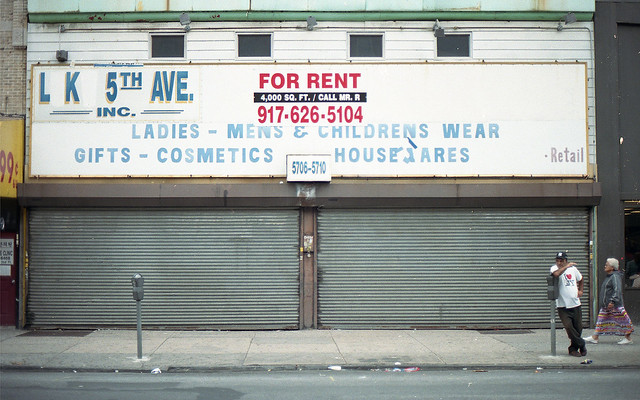
(photo: @shootingbrooklyn)
As a small business owner in New York City for 11 years, I believe it is imperative that city officials reframe the current debate over whether or not we face a small business crisis. In an August column for Gotham Gazette, Carol Kellermann used the results of a recently-published New York City Department of City Planning report on storefront vacancies as well as observations of her Upper West Side neighborhood to assert two conclusions: there is no citywide small business crisis and therefore the City Council should not enact citywide legislation to address a problem found in a small number of neighborhoods.
But the City Planning report data does show great struggle for small businesses and both the column and the report fail to capture the link among vacancies, small business closures, and the loss of neighborhood vitality and affordability.
The report pulls data from a nine-month average between 2017 and 2018 in 24 shopping corridors and uses an “industry standard healthy vacancy rate” of 5-10% as its benchmark. Putting aside the question of whether or not that is the best benchmark, the report found that 15 of 24 corridors studied - a majority - had vacancy rates above 10%. Across these 15 corridors, the average vacancy rate was 14.94%.
The question then should not be what number of high vacancy corridors constitutes a crisis but what do small business closures and high vacancies mean for neighborhoods and New Yorkers seeking work?
If for a case study we look at Williamsburg, one of the 24 retail corridors studied and with a reported vacancy rate of 16.6%, we can find two important answers: one, vacancies can mean a decline in access to useful goods and services that serve the neighborhood’s interests and means; and two, vacancies can mean a loss in high quality service and retail jobs.
To the first point, I closed my successful kitchenware shop in Williamsburg this April because my landlords demanded a 44% rent increase in order to renew for only five years (with 3% annual escalations). At the end of my 10-year lease I was already paying $18,452 per month for my 1,450 square feet. And I could afford to pay that because we had many loyal customers. We were not suffering from online retailers.
I would have paid $20,000 per month to stay, arguably a high rent, but the landlord demanded $26,500. The space has now been divided into three retail units, two of which are occupied. The largest is a ‘modern wellness’ business that offers whole body cryo and an oxygen bar. Whereas you could come to my kitchen shop and spend as little as $24 on a frying pan for daily cooking, now you can purchase a 3-minute cryo session for $75.
Across the street, private equity owned, luxury beauty brand NK Space Apothecary moved in. Sephora, Apple, Whole Foods, Citibank, Duane Reade, Equinox, Levi’s, G Star Raw, to name but a few major chains, now occupy prime retail in Williamsburg.
There is nothing wrong with any of these businesses. The problem is when too many businesses in a neighborhood are like these; when access to useful services and goods diminishes because they are replaced by too many luxury brands, too many duplicative services, and too many uninviting chains. A non-stop refrain from upset customers in our final days was that they “didn’t like their neighborhood any longer”.
Neighborhoods are ecosystems in which residents and services interact in an ongoing exchange of trades. But when trades diminish because fewer affordable and necessary goods are available, the ecosystem weakens. That fragility is exemplified by buyers turning more to online shopping (with all its attendant waste and pollution) and by residents being priced out of their neighborhoods.
To the point that vacancies can mean a loss in high-quality service and retail jobs, when I closed Whisk, seven staff lost their jobs and several are still seeking stable employment. Kellermann cites the loss of a beloved diner in her neighborhood which then sat vacant for two years. That two years represents meaningful unemployment for our neighbors, friends, and maybe family. It’s also about the quality of small business jobs. By virtue of being small, we can apply a sales associate’s talent for photography, numbers analysis, or web design to the business in ways that chains simply can’t.
Kellermann concludes that rents will come down so we don’t need citywide legislation now. Rents have softened in select areas but being down does not equal affordable. If a 1,000-square-foot space drops from $350 per square foot to $300 per square foot, it is still $25,000 per month. How many retailers or bars generate revenues to afford that? Not many. Moreover, small businesses are usually designed to provide a particular service in a particular neighborhood. They cannot simply pick up, finance a relocation to a new corridor or even side street, and recreate that market.
Citywide policy is absolutely needed to reframe this debate. Imagine how different Williamsburg would be in 2019 if we had had a zoning purview to limit chain retail; if we had been bold enough to talk about commercial rent stabilization; if we had mandated mitigation measures to protect against commercial and residential displacement?
Cities like San Francisco and London are having these conversations. New York absolutely needs to get ahead of understanding what vacancies mean for our neighborhoods.
***
Natasha Amott is the owner of Whisk, in downtown Brooklyn. On Twitter @Natasha_Amott.
***
Have an op-ed idea or submission for Gotham Gazette? Email This email address is being protected from spambots. You need JavaScript enabled to view it.
Sentenced to Death by Incarceration in New York State Prison

Eastern Correctional (photo: wikimedia commons)
The conversation around criminal justice reform is finally moving from general talk about mass incarceration to the specific reality of the multitude of people serving massive sentences. The more accurate description of these sentences – death by incarceration – is replacing antiseptic phrases like “life without parole.” These long-term sentences are, in truth, sentences to death in prison.
Several years ago, the Defenders Clinic at CUNY Law School began working with people serving death in prison sentences on their only path to freedom: gubernatorial clemency. While we have worked with only a small fraction of the nearly 9,000 people serving life sentences in New York, it is enough to reveal the criminal legal system’s obsession with processing, convicting, and punishing.
Virtually everyone we have worked with was convicted after a trial, the case for most people serving life sentences in New York. This raises two questions: why weren’t those cases resolved through plea negotiations like virtually all other criminal cases, and what was the justification for meting out massive sentences on people who exercised their constitutional right to trial?
In several cases, we heard from clients that the defense lawyer never mentioned any plea offer. In many others, we heard about plea offers being superficially conveyed but virtually no time spent having the difficult yet crucial discussion of the pros and cons of a plea versus a trial. We repeatedly heard about a complete lack of advice from the attorney about the wisdom of accepting or rejecting a plea offer.
It became clear from conversations with lifers that many of their assigned lawyers had been eager to take cases to trial and forgo the serious consideration of a plea, especially since most were being paid an hourly rate by the court and had a financial incentive to take a case to trial regardless of the risks to their clients.
Almost all the people we worked with were represented by a lawyer assigned by the court. They had no say in who their lawyer was and had no realistic way of replacing that lawyer (and many tried). Over and over we heard the same thing: ‘my lawyer did not come to the jail to meet with me a single time while my charges were pending.’
We also learned that the failures of many of these attorneys did not end with the lack of client counseling. Considering the enormous sentences handed down after trial, perhaps the lawyers’ greatest deficiency was at the sentencing proceeding itself. In most cases, there was no pre-sentence memorandum supporting an argument for a lesser sentence and no mitigation advocacy of any kind.
In several cases, sentencing advocacy consisted of a few generic sentences from counsel asking the court to be lenient. In one case, there were serious pretrial issues regarding the accused’s mental capacity, but at sentencing the defense counsel said nothing about his client’s documented history of mental illness.
It would be a grievous mistake to blame defense counsel for all the ills that define the criminal legal system. After trial, prosecutors routinely asked judges to impose the maximum sentence and judges were glad to oblige, often tacking on consecutive sentences to ensure that the person would die in prison -- and to send a loud message to anyone else who had the temerity to insist on the right to a trial.
One man was offered a plea of three to nine years, went to trial, and is currently serving 25 to life. Another was offered 25 to life pre-trial yet sentenced after trial to 125 to life. Some argue that plea offers are a discount and a necessary ingredient of the adjudication of criminal cases in an imperfect system. However, such disparate outcomes – 25 to life if you plead, 125 to life after trial – cannot be justified.
As we spent more time with those serving life sentences, we saw the impact of a merciless and punitive system in countless ways.
Many lifers are from rapidly gentrifying parts of New York City. Most were sentenced in the 1980s. They are black and Latinx. A majority are from places like Bedford-Stuyvesant, Crown Heights, and the Lower East Side. Their families were long ago priced out of the neighborhood as long-neglected zip codes have changed so drastically that the lifers would barely recognize where they grew up.
In New York, there are 613 lifers who were 17 and under at the time of their charges. There are thousands more convicted when they were 18, 19 or in their early twenties. Many are now in their forties and fifties having served decades in prison for crimes committed in their youth when labels like “super-predator” fed into racist narratives and massive sentences.
Yet neuroscience now informs us that brain development continues into our mid-twenties. Even the Supreme Court now recognizes that youth have an underdeveloped sense of responsibility, are less culpable than adults, and have a greater capacity for rehabilitation. A growing number of states have passed laws that give young offenders an opportunity to seek parole or a sentence reduction after having served a proscribed number of years in prison. There is no similar movement afoot in New York to correct those morally indefensible, and arguably illegal, sentences.
There is a rapidly growing aging population in New York prisons. These people have long since aged out of any real possibility of future criminal behavior. Many are dying. New York has a mechanism in place for compassionate release for those with terminal illness but from 2013-2017 only 72 people were granted medical release.
Many law students came to this work inspired by Innocence Projects across the country. We have worked with several people with undeniable innocence claims that have fallen on deaf prosecutorial and judicial ears. But while the students wanted to join the battle for justice for the wrongly convicted, they soon discovered a much larger area of unjust convictions – the many lifers who, even if not factually innocent, were denied any semblance of due process.
One man’s lawyer, unbeknownst to him, had a pending lawsuit against New York City based on an incident where a client less than a year earlier slashed him with a razor during a visit in the holding cells. As part of that lawsuit, the lawyer testified that he was seeing a psychiatrist and had trouble relating to clients.
Another man’s lawyer, unbeknownst to him, was under investigation by the very same District Attorney’s office prosecuting him. The lawyer was indicted soon after the verdict (and ended up in state prison), and a new lawyer appeared at sentencing.
In another case, the defense claimed that a prosecution witness had been coerced into testifying falsely by the prosecutor. That prosecutor thereafter became a defense attorney and is now in federal prison for suborning perjury.
Another man is serving a life sentence based on a case where the lead detective turned out to be a serial murderer for the mob. The police file in the case is nowhere to be found.
In each of these cases, all appeals were fought by the prosecution and denied by the court.
Since we were working with people serving life sentences, many students assumed that these were people convicted of murder; people who had taken a human life. However, many of the lifers we’ve worked with were convicted of felony murder, a rule that allows a person to be charged with murder even if the death is at the hands of someone else. Several people did not kill anyone, fire any shots, possess a weapon, or have any intention, or even expectation, that anyone would be killed. Still, because they participated in an underlying robbery, they were convicted of felony murder and given a life sentence. Several of these men were teenagers at the time they were arrested. There is a growing movement for states to reconsider the felony murder rule, but New York is missing in action.
We have worked with only a small number of the people serving life sentences in New York, and an even smaller percentage of the 47,000 people in state prison. Nevertheless, we have found ample reason to fear that the impact of long overdue criminal justice reforms, trumpeted daily and endorsed by countless politicians, may be far less than hoped until the extant incarceratory system within which those changes operate is dismantled or radically overhauled.
Meanwhile, it is time to demand clemency for the countless number of people who merit that relief, and to create second-look mechanisms that require immediate review of the massive sentences that fed mass incarceration.
***
Steven Zeidman is a professor of law at CUNY School of Law and a former Public Defender. On Twitter @SteveZeidman.
***
Have an op-ed idea or submission for Gotham Gazette? Email This email address is being protected from spambots. You need JavaScript enabled to view it.
How to Close Rikers with No New Jails
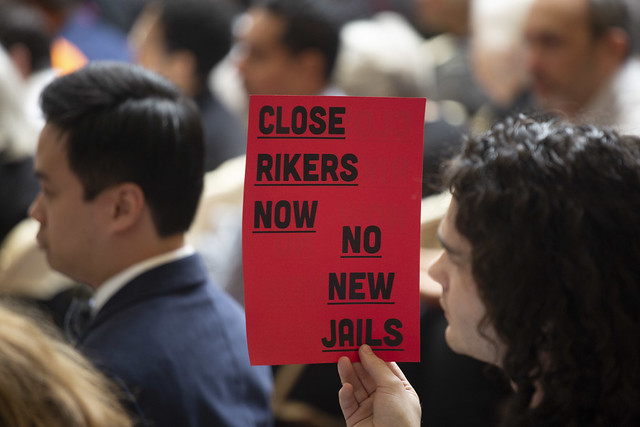
(photo: John McCarten/City Council)
While not surprising from a political perspective given Mayor de Blasio's support for the plan, the City Planning Commission's recent vote to approve the very costly (about $9 billion current estimate) construction of new jails for the worthy purpose of closing the deeply inhumane facilities on Rikers Island was wrong and wrong-headed.
As the City Council now considers the four-jail plan, one in each borough but Staten Island, it should recognize that the city can take the much smarter and cheaper course: sufficiently reduce the overall jail population so it can close the Rikers jails and house the remaining imprisoned New Yorkers in the already-existing borough facilities, which have the capacity to hold about 3,000 people.
Here's how and why:
About 70% of the approximately 5,000 New Yorkers confined on Rikers are pre-trial detainees, presumed innocent under our system of justice, locked up mainly because an NYPD officer has arrested them and they are too poor to afford even the low bails set on them. The major bail reforms passed in Albany earlier this year will, as of January 2020, substantially limit the kinds of cases where judges can apply bail, thereby contributing to a significant reduction in the number of people remanded to Rikers.
None of the many sentenced people confined on Rikers have been convicted of serious offenses. If they had been, they would have been sent to a state prison. Many of them serve terms of 90 days or fewer. The city could readily find alternative ways to respond to most, if not all, of their cases.
Mayor de Blasio has rejected the blue-ribbon Lippman Commission's most important recommendation, which is to decriminalize four offenses: fare evasion, sex work, marijuana possession, and gravity knife possession (Albany did enact legislation in June legalizing the latter).
De Blasio backs NYPD "broken windows" policing, which targets and arrests low-income New Yorkers of color for petty infractions, sometimes via false arrests and bogus summonses, that police virtually ignore in white areas. Ending this starkly biased law enforcement tactic and following the Lippman Commission's proposal to decriminalize offenses above would contribute appreciably to reducing the population on Rikers.
In addition to ending "broken windows" practices, the city should jettison the NYPD quota system that puts pressure on officers to make a prescribed number of arrests and stops and to issue a certain number of summonses in order to earn positive job evaluations and to qualify for promotions and sought-after posts. While NYPD brass deny the existence of quotas—they are illegal, after all— a number of whistle-blowing officers have attested publicly (and privately to PROP representatives) about their use and the consequent harmful effects on cops and the community.
The Department is known, for example, to sanction officers who do not "make their numbers" by assigning them to precincts far from their homes -- dubbed "transportation therapy" -- or by denying them time off even for family emergencies.
The city could and should establish a task force accountable to City Hall that monitors court case processing. New York City's legal culture permits our courts to move much more slowly than other municipal systems in our country. The task force can, for instance, put pressure on judges to limit the number of court appearances per case as a way to prevent the longtime incarceration of detainees -- the tragic case of Kalief Browder comes to mind -- as they await disposition of the charges against them.
As city officials talk up new “modern” jails, the famous George Santayana quote is noteworthy here: "Those who don't remember the past are condemned to repeat it." I have worked on prison and related issues for nearly 50 years and cannot recall a single instance in history where promises that the new proposed facility will break the cycle of corruption and abuse that plague jails has become reality.
Opened in 1931, Attica was the most expensive prison in the world, advertised as being equipped with all available modern amenities and as being safe and humane. Similar claims were made regarding Rikers Island when the city opened jails there in the 1930s.
People now claiming that the proposed new jails, run by the same Department of Correction and personnel responsible for Rikers, will not feature the same harsh and perilous conditions of confinement as Rikers are drinking an age old Kool Aid -- some are engaged in pouring it.
Closing Rikers without spending billions of dollars on unneeded new jails —under this no new jails plan the city will have to allocate some funds to fix up, and improve conditions inside, its existing borough facilities—will not only remove from our great city's landscape the stain of operating notorious Rikers jails. It will also eliminate some of our police and criminal justice systems' abusive and discriminatory practices that inflict harm and hardship on vulnerable New Yorkers every day. Our city will be a better place for it -- more just, safe, and livable for all our people.
***
Bob Gangi is Director of the Police Reform Organizing Project. On Twitter @GangiFromPROP & @PROPNYC.
***
Have an op-ed idea or submission for Gotham Gazette? Email This email address is being protected from spambots. You need JavaScript enabled to view it.
I Was Andrew Yang’s First ‘Freedom Dividend’ Recipient - When He Fired Me
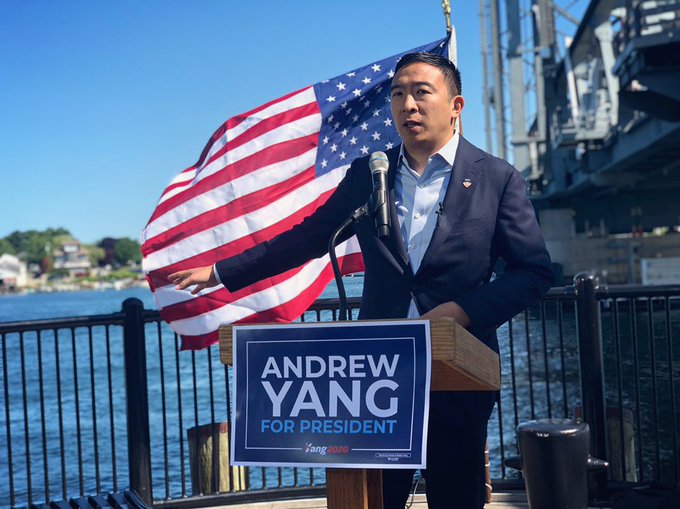
Andrew Yang (photo: @AndrewYang)
After the game show stunt that Andrew Yang pulled at the presidential primary debate last week, a lot of people have speculated that he should and will drop out of the race soon. But there is another reason why Andrew Yang doesn't belong on the national political stage, and it involves the reason that Yang fired me in 2007 and how my termination highlights the danger of his "freedom dividend" program.
Manhattan GMAT is a testing preparation company, founded in 2001, to help people get ready for the Graduate Management Admission Test, often used for business school programs, among others. I was its first employee and its primary revenue generator during the start-up years. I had been one of the first Manhattan GMAT teachers, so I knew the test really well, and in the early days, I spoke to every single student, every single customer.
I forged relationships with marketing partners. I created our advertising collaterals. I taped posters to bus stops on Broadway, and I gave out cookies to hungry young bankers at open houses. I even snuck postcards into our competitor's books at the bookstore to grow the company. As the Marketing and Student Services Director, I met all of my revenue marks. By 2005, we'd expanded to other cities and were a multi-million dollar operation.
Then, Andrew Yang became president of the company. He had taught a couple of classes over the years, so I knew him already, but he was not at all involved in the company's operations before then. He promoted me to Senior Director just after he started, and again, I hit all of my growth targets.
Imagine my surprise, then, that on the third day that I was back to work after my honeymoon in 2007, Andrew Yang fired me. Our private discussion, in his office with the door closed, began with Andrew's remarks that because I was married, I wouldn't want to continue working as hard as I had been. That as a wife, I'd be focused on my new life.
At-will employees are let go all the time. I could be fired at any time without a reason.
But Andrew did give me a reason. I didn't even realize at the time how unethical his reason was. I was singularly focused on the embarrassment I felt. How could he fire me after all that I had accomplished at the company. And the horror I felt knowing that I'd have to tell my new husband that our life was shattered (he made less than 15% what I did).
Andrew must have calculated that I would work less, travel less, put in fewer hours as a married woman, yet still earn my six-figure bonuses. He had seen how seamlessly my staff had performed while I was on my honeymoon. He probably thought that they would do the work cheaper. With my compensation package off the books, several college grads could be brought in to spread the work around. And just like that, my wedding and honeymoon had rendered me obsolete from the company that I had helped to build.
Since the termination was couched for me, as a "freedom to move on" narrative, the deal Andrew Yang offered me was commensurate with what he believed I deserved, a monthly payment for no longer working. For two years. I agreed in the end (part of a much longer story) to go away, to take the monthly payoff, which paved the way for the company to develop more sophisticated money-making initiatives at cheaper costs.
Sounds a lot like Yang’s "freedom dividend" platform doesn't it? Yang is basically telling the American public that the government will pay them off each month. Rather than governing our way into a sustainable economy, Yang's plan absolves the government from overseeing companies that could render countless workers obsolete. With a monthly payment, the under-educated, aging, perhaps newly married - the obsolete employees - recede into the background as trillion-dollar companies continue to grow unfettered and ungoverned as they have for decades.
Candidates for elected office must be scrutinized more. Past behavior is a predictor of future behavior. And behavior is a reflection of values. The values that it takes to shatter a successful woman's livelihood days after she marries is a deal-breaker for a presidential candidate. At least it should be for women. We have been suppressed, discriminated against, harassed, and abused for far too long, and often behind closed doors, where we are left to carry the burden of shame for actions carried out against us.
Even more importantly, Americans shouldn't take the carrot of a monthly payout without understanding what the deal really means. The “freedom dividend” means that workers are no longer believed to be valuable, that they can't learn new skills, develop new industries and adapt to an ever-evolving existence in our great country. What a depressing approach to the future!
The Democratic Party has a wide array of highly-qualified, committed public servants from which to choose. Andrew Yang is not one of them.
***
Kimberly Watkins is a running and fitness coach in Manhattan and serves as the President of the Community Education Council, in New York City Public School District 3 on the Upper West Side and Southern Harlem. On Twitter @kimwatkinsnyc.
***
Have an op-ed idea or submission for Gotham Gazette? Email This email address is being protected from spambots. You need JavaScript enabled to view it.